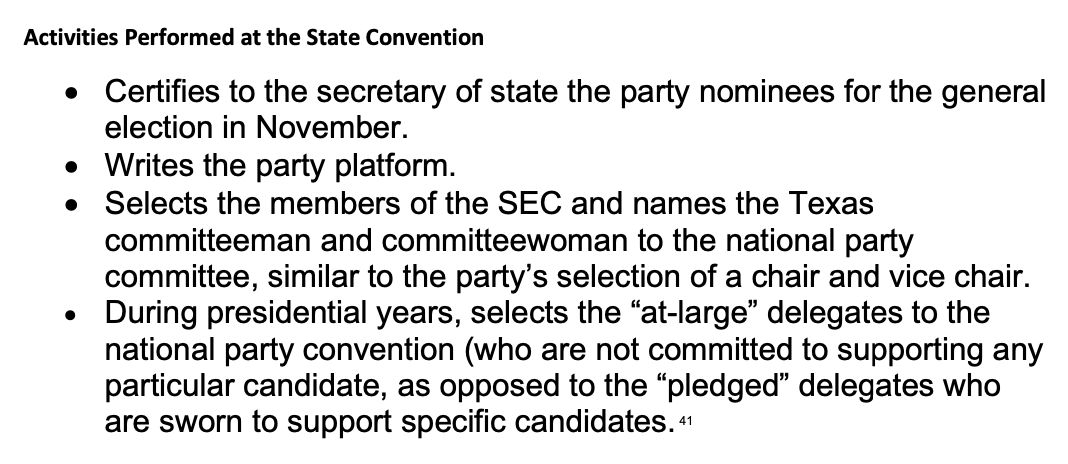4.3: Welcome to the Party! Examining Party Organization
- Page ID
- 129154
While individual Texans may be strongly connected to one political party or the other for years or even decades, the party organizations themselves are in a constant state of renewal. Political parties are organizations, but the way they are structured can differ. When they are well organized, they can function very effectively, but when they are not, it can lead to gridlock and difficulty in drafting clear policy. In Texas, political parties are organizationally weak.
Most states, including Texas, have political parties that are divided into a permanent party organization and a temporary party organization. The permanent party organization is a small, fixed organization that handles the routine business of a political party. consists of little more than a skeleton force of people who conduct the routine but essential business of the
party. Because they main purpose of the party is to win elections, during election years more people are needed in order to succeed. Therefore, during election years the party but boost its activity through a temporary party organization with the goal to gain power. A temporary party organization is formed to mobilize the party’s potential electorate and win an election. The temporary party organization focuses on elections. It tries to select appealing candidates who can win and tries to mobilize voters to support them38 (Figure 4.8).

In Texas’s 254 counties, there are more than 6,000 precincts, each having from fifty to as many as 3,500 voters. Each voter is entitled to vote for the precinct chairperson and propose and vote on resolutions that establish party policy, but voter participation in party affairs is low. Normally, only a small fraction of those who vote in the primaries—who are themselves only a fraction of the total number of registered voters and a smaller fraction of citizens of voting age—participate in conventions or other party affairs.39
The main function of the precinct convention is to select delegates to the county convention, which is the next level of the temporary party organization. The main function of the county convention is to select delegates to the state convention. Both precinct and county conventions can be either short or long, peaceful or filled with conflict, productive of resolutions or not.40
The state convention is the highest-level part of the temporary party organization, meeting in June of even-numbered years. State conventions are generally more formal and more scripted, with thousands of delegates, featuring more speeches and less open debate.
The party platform for each party is drafted by a platform committee, but is sometimes discussed in floor debate, and can frequently be controversial. The parties’ platform positions are good indications of the values and beliefs of the major party activities as groups, but—as most older Texans well know—they are not always reliable guides to the issue positions taken by individual candidates.41
Finally, in presidential election years, state conventions must choose a slate of electors to represent the state in the electoral college should that party’s nominee receive a majority of the state’s votes in the November election.
Participants in these conventions also elect members of a permanent party organization that will run the day-to-day operations of the party until it is recreated by the next series of conventions two years later.
There are permanent party officials at each level at which temporary party organizations exist. The precinct chair is elected by voters who participate in that party’s primary election in that precinct. At the county level, all the precinct chairs in the county form the party’s county executive committee. The county’s party chair is elected by voters in the party primary election. Members of each party’s state executive committee are elected by delegates at the state convention—one man and one woman from each of Texas’s thirty-one senatorial districts. Delegates to the state convention also select the party chair and vice chair.
A list of the major activities performed at the State Convention follows in Figure 4.9.

38. Dautrich, et al., American Government: Texas Edition.
39. Dautrich, et al., American Government: Texas Edition.
40. Dautrich, et al., American Government: Texas Edition.
41. Dautrich, et al., American Government: Texas Edition.

